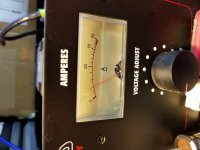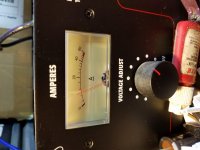Is there any way to disconnect the power supply side from the class D side like the older bd's? Maybe that would help me in trouble shooting?
I thought of changing the regulators like the other amp on the forum but without knowing what the readings were before he changed them I'm not sure anything will change.
I thought of changing the regulators like the other amp on the forum but without knowing what the readings were before he changed them I'm not sure anything will change.
Does the audio side get hot at idle?
For one 2500 that I have here, the amp draws about 2.1 amps before the class D is engaged and about 4.4 amps after.
The amp I have has the 55947 driver board.
For one 2500 that I have here, the amp draws about 2.1 amps before the class D is engaged and about 4.4 amps after.
The amp I have has the 55947 driver board.
I've never let it idle for more than 2-3 minutes and played audio for only a minute or so. I didn't want to risk damage just in case. I haven't noticed anything getting hot other than the 2 large white resistors next to the regulators.
One thing I will add the current draw is sensitive to voltage input adjustments from the power supply. The lower the voltage the less the draw, the higher the voltage the bigger the draw. If I get up around 14.50 volts in the current draw pulses a little on the meter.
Its hard to tell the exact draw with my meter as I don't have a clamp.
I posted 2 pictures one at 14.4vdc and one at 12.8 vdc
One thing I will add the current draw is sensitive to voltage input adjustments from the power supply. The lower the voltage the less the draw, the higher the voltage the bigger the draw. If I get up around 14.50 volts in the current draw pulses a little on the meter.
Its hard to tell the exact draw with my meter as I don't have a clamp.
I posted 2 pictures one at 14.4vdc and one at 12.8 vdc
Attachments
See also #22.
If C118 serves the same purpose on all BD PS boards, soldering a jumper across its terminals should prevent it from charging and prevent the output stage from switching on.
Confirm that the passing of 4v on its positive terminal corresponds to the switching on of the output stage.
If C118 serves the same purpose on all BD PS boards, soldering a jumper across its terminals should prevent it from charging and prevent the output stage from switching on.
Confirm that the passing of 4v on its positive terminal corresponds to the switching on of the output stage.
Sometimes its a little higher than these photos like with a load connected and a source connected but not much.
I'll confirm this tomorrow and post results. So as soon as the cap reaches 4vdc on the positive terminal the output stage switches on correct?
If I still have the draw then I'll know there is a problem in the power supply.
If I don't it must be in the audio side. Its hard to know how much the audio side should draw. Other 2500's I have had here did not draw this much current.
If I still have the draw then I'll know there is a problem in the power supply.
If I don't it must be in the audio side. Its hard to know how much the audio side should draw. Other 2500's I have had here did not draw this much current.
For the amp I have here, the input voltage 12-13.8 didn't make the current draw change more than a tiny fraction of an amp.
Yes to the first question in #26.
Does the rail voltage change much (measured between the center legs of the rectifiers) as you adjust the input voltage?
Does that voltage ever exceed the rated voltage of the rail caps?
Yes to the first question in #26.
Does the rail voltage change much (measured between the center legs of the rectifiers) as you adjust the input voltage?
Does that voltage ever exceed the rated voltage of the rail caps?
The rail voltage is sensitive to input voltage, but does not exceed the caps limit.
At input of 12v = 111v rail
At input of 14v = 147v rail
At input of 12v = 111v rail
At input of 14v = 147v rail
C118 reaches about 3.8vdc the output stage switches on then the cap jumps to 4.56vdc and stays there.
Does jumping C118 stop the output as you wanted?
I didn't go to 14v but I got 112v to 130v at 12-13.8v (measured directly on the terminals of the amp, not at the 12v power supply). Your readings seem about the same as in this amp.
I didn't go to 14v but I got 112v to 130v at 12-13.8v (measured directly on the terminals of the amp, not at the 12v power supply). Your readings seem about the same as in this amp.
I have not tried this yet Perry. I will try it tonight. I have been playing the amp for about 30 min. on an 18" sub at low volume 10 of 30 on my test bench. Everything seems fine other than the current draw. The heat sink is staying about 100 degrees.
The only place I noticed it was warmer is directly contacted to the LM317/337 and it is 124 degrees.
Maybe this is just how this amp is but something is telling me its not right.
The only place I noticed it was warmer is directly contacted to the LM317/337 and it is 124 degrees.
Maybe this is just how this amp is but something is telling me its not right.
I pushed the amp a little harder and as it got around 130 degrees the current draw rose to 10 amps. Something is wrong this amp is frustrating.
It still works fine and sounds great, I don't get it.
It still works fine and sounds great, I don't get it.
Jumping C118 disabled the output stage. The amp idles at 2.5 amps.
When I adjust the input voltage now the amplifier corrects itself to stay at 118vdc no matter what the voltage.
I'm thinking there is an issue in the output stage. I'm not sure where as the amplifier works good as far as audio.
The original problem was a shorted insulator to the heat sink and some blown outputs. Even if some smd components were still bad generally this won't cause a current draw.
I think I will change the regulators LM317/337 to see if it eliminates the draw as the other amplifier on the forum this worked for.
When I adjust the input voltage now the amplifier corrects itself to stay at 118vdc no matter what the voltage.
I'm thinking there is an issue in the output stage. I'm not sure where as the amplifier works good as far as audio.
The original problem was a shorted insulator to the heat sink and some blown outputs. Even if some smd components were still bad generally this won't cause a current draw.
I think I will change the regulators LM317/337 to see if it eliminates the draw as the other amplifier on the forum this worked for.
Your multimeter measures frequency. You should be able to measure it by measuring across the gate and source of any of the output FETs.
I will be able to measure it with the output stage disabled or do I have to remove the jumper on C118?
I'm not sure. Try measuring on the drain of either Q200 or Q201, black on the main ground terminal.
Edit:
Those transistors are on the back of the class D driver board.
Edit:
Those transistors are on the back of the class D driver board.
Last edited:
- Status
- Not open for further replies.
- Home
- General Interest
- Car Audio
- Rockford Fosgate T2500-1bdcp

